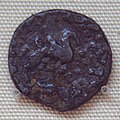| Vima Kadphises | |
|---|---|
| Kushan emperor | |
 Double stater of Vima Kadphises. Obverse: diademed and crowned figure of Vima Kadphises seated facing on stool with ornate legs, head left, feet on footstool, holding laurel branch in raised right hand. Corrupted Greek language legend: ΒΑΣΙΛΕΥΣ ΟΟΗΜΟ ΚΑΔΦΙϹΗϹ ("Basileus Ooimo Kadphisis"): "King Vima Kadphises". Afghanistan. Guimet Museum, MG24356 | |
| Reign | 113–127 CE |
| Predecessor | Vima Takto |
| Successor | Kanishka |
| Dynasty | Kushan |
| Religion | Shaivism [1] |
Maharaja rajatiraja devaputra
Kushanaputra (Shahi Vamataksha) masya
Vakanapatina Huma (devakulu) karita
Contents
Arama pushkarini udapana (cha) sa-da (kothako) [3]Mathura Museum.
Vima Kadphises (Greek: Οοημο Καδφιϲηϲ Ooēmo Kadphisēs (epigraphic); Kharosthi: 𐨬𐨁𐨨 𐨐𐨫𐨿𐨤𐨁𐨭Vi-ma Ka-lpi-śa, Vima Kalpiśa) was a Kushan emperor from approximately 113 to 127 CE. According to the Rabatak inscription, he was the son of Vima Takto and the father of Kanishka.

















